Ever thought your diet could fight chronic inflammation? What you eat is key to your health and can either help or hinder inflammation. This meal plan introduces a week of foods that fight inflammation, nourishing your body and easing pain.
By learning about *healthy eating for inflammation*, you can improve your well-being. Many athletes and wellness experts already do. Are you ready to change your meals for relief? Let’s start!
What is an Anti‑Inflammatory Diet?
An anti-inflammatory diet fights chronic inflammation caused by bad food choices. It includes foods that help your body fight off inflammation. This diet is key to managing your immune system.
Inflammation is good for protecting us from harm. But too much can cause serious problems like heart disease and diabetes. The right diet can greatly improve your health.
Understanding Inflammation and Its Effects
Chronic inflammation comes from lifestyle choices, including diet. It can cause many health issues. Signs like fatigue or joint pain mean it’s time to eat healthier.
Foods to Include and Avoid
To follow an anti-inflammatory diet, eat foods that support your body. Include:
- Fruits like berries and cherries
- Leafy greens such as spinach and kale
- Whole grains, including brown rice and quinoa
- Healthy fats, like olive oil and avocados
Avoid processed foods with sugar, trans fats, and refined carbs. These choices help the most with an anti-inflammatory diet.
Benefits Beyond Pain Relief
An anti-inflammatory diet does more than just ease pain. It also boosts mood, digestive health, and lowers disease risk. It’s a great way to improve your life.
How an Anti‑Inflammatory Diet Works
An anti-inflammatory diet is a natural way to fight pain and improve health. It focuses on foods that are good for you. These foods help reduce inflammation in your body.
Antioxidants and omega-3 fatty acids are key. They help keep your body’s inflammation in balance.
Role of Antioxidants
Antioxidants are important for fighting inflammation and protecting your body. Foods like berries, nuts, and dark greens are full of them. They fight off harmful free radicals.
This lets your body’s cells work well. Adding these foods to your diet can help reduce inflammation and boost your immune system.
The Impact of Omega-3 Fatty Acids
Omega-3 fatty acids are essential for fighting inflammation. You can find them in fatty fish like salmon and mackerel. They help your body stay away from chronic inflammation.
Adding these to your diet can improve your health. When looking for anti-inflammatory foods, don’t forget to include omega-3s for the best results.
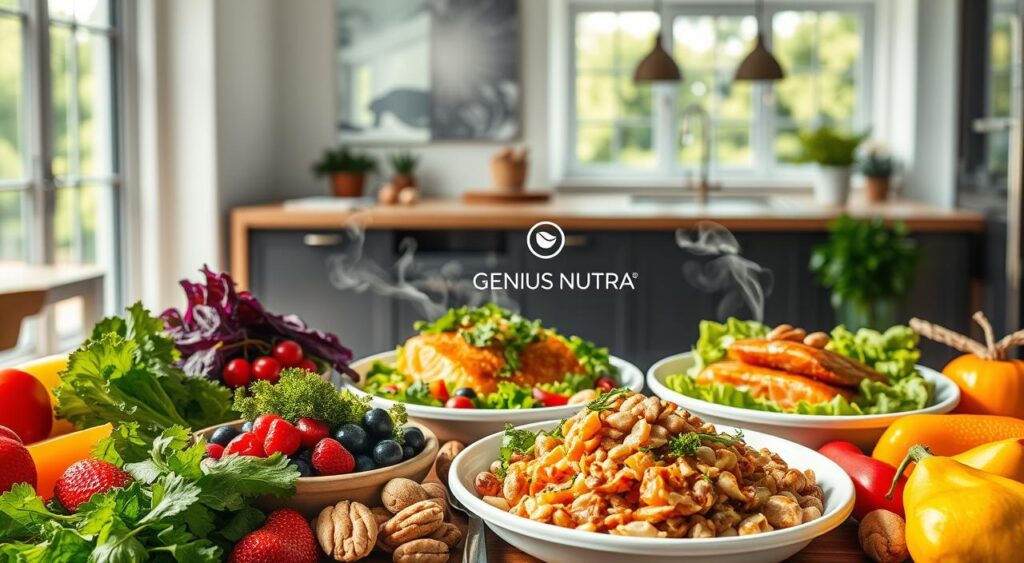
One-Week Meal Plan Overview
This meal plan offers a variety of anti-inflammatory meals to help reduce discomfort and improve health. Each day, you’ll find meals from breakfast to dinner, plus snack ideas. These snacks help keep your diet balanced and inflammation low. The plan is flexible, making it easy to fit into a busy schedule without giving up on health.
Daily Layout of Meals
Here’s a breakdown of the daily meal layout that ensures you experience the benefits of an anti-inflammatory diet:
| Day | Breakfast | Lunch | Dinner | Snacks |
|---|---|---|---|---|
| 1 | Mashed avocado on whole grain toast | Tuna salad sandwich with a side salad | Chickpea spaghetti with no-sugar-added pasta sauce, ground turkey meatballs, and roasted broccoli | Greek yogurt with mixed berries |
| 2 | Overnight oats with cherries | Shrimp, avocado, and lettuce wrap with fresh herbs and lemon juice | Grilled salmon with asparagus and sweet potato | Turmeric latte and a handful of nuts |
| 3 | Chia pudding with orange slices and blueberries | Chicken and pesto flatbread pizza with asparagus | Tempeh, bok choy, and mushroom stir-fry with rice, ginger, and soy sauce | Sliced pears and Gouda cheese |
| 4 | Yogurt parfait with blueberries and walnuts | Cobb salad with hard-boiled eggs | Fish tacos with red cabbage slaw | Matcha latte and nut butter on whole grain toast |
| 5 | Protein berry and avocado smoothie | Pasta salad with chicken and spinach | Grilled steak with roasted butternut squash and a side salad | Bottled kefir and a pomegranate |
| 6 | Spinach and mushroom egg scramble | Hummus, turkey breast, and veggie sandwich on whole wheat bread | Turmeric-spiced baked chicken thighs with roasted cauliflower and a baked sweet potato | Hibiscus tea and seed crackers with nut butter |
| 7 | Banana pancakes | Sushi bowl with rice, avocado, crab meat, sesame seeds, seaweed strips, and soy sauce | Roasted chickpea salad with whole grain pita bread triangles, lettuce, tomato, feta cheese, and Greek dressing | Lacto-fermented pickles and fresh fruit |
Snack Suggestions Included
Snacking is important for managing hunger and staying healthy. Try raw nuts, fresh fruits, or yogurt with berries. These snacks are tasty and good for you. For more anti-inflammatory meal ideas, check out this link. It’s perfect for meal prep and keeps you energized all week.
Day 1: Delicious Beginnings
Start your anti-inflammatory diet with tasty, healthy meals. This will make your week more enjoyable. You’ll get to try many new dishes that are good for you. Here are some yummy anti-inflammatory recipes for Day 1.
Breakfast Ideas
Begin with a warm bowl of oatmeal. Add fresh berries and chopped nuts on top. Oats give you fiber, and berries are full of antioxidants. They help fight inflammation.
Lunch Options
For lunch, try a quinoa salad. It has leafy greens, cherry tomatoes, and cucumber. Dress it with olive oil and lemon juice. This meal is full of healthy fats and vitamins, helping to reduce inflammation.
Dinner Recipes
Finish the day with baked salmon and roasted vegetables. Salmon has omega-3 fatty acids, which fight inflammation. The colorful veggies add more nutrients to your meal.
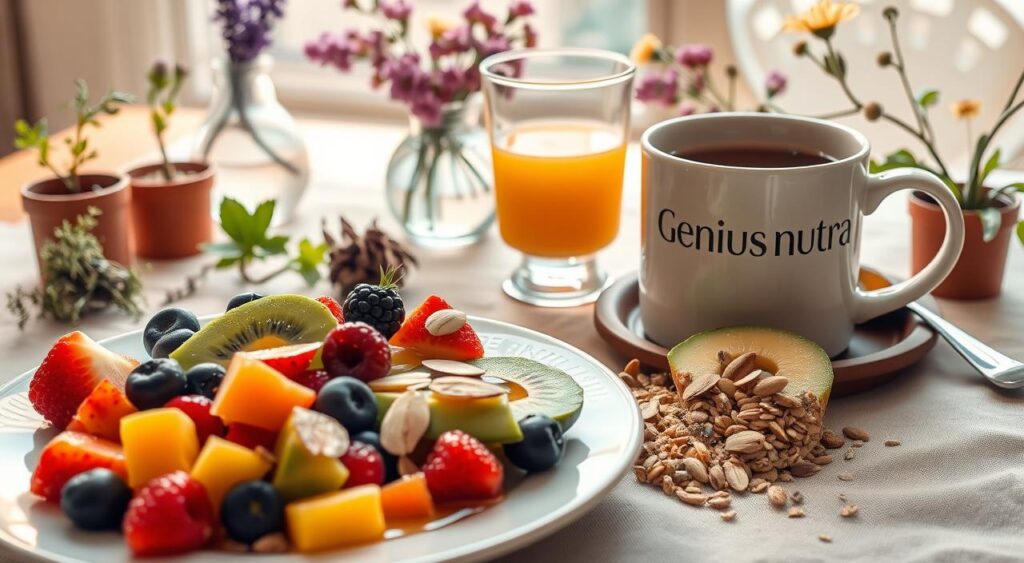
Day 2: Vibrant Choices
On Day 2, dive into the world of colorful, nutritious foods. These foods not only taste amazing but also boost your health. Your meals will keep you energized and fight inflammation with tasty, anti-inflammatory dishes.
Breakfast Variations
Begin with a refreshing smoothie bowl. Mix fresh spinach, ripe avocado, and frozen berries for a nutritious start. Add chia seeds and sliced almonds for extra texture and nutrients.
Midday Meals
For lunch, try a hearty lentil soup. Mix lentils with carrots, celery, and spices for a protein and fiber-rich meal. Serve with a side salad in olive oil and lemon for extra healthy fats.
Evening Feast
As evening approaches, grill chicken with zucchini and bell peppers. Drizzle with balsamic glaze for flavor. This meal balances vibrant tastes with health benefits.

Day 3: Colorful and Nutritious
On Day 3, you’ll explore the world of colorful fruits and veggies. These are key in any anti-inflammatory diet. They add nutrients that fight inflammation and make your meals exciting.
Morning Picks
Begin with a chia seed pudding. Mix chia seeds with almond milk and let it thicken overnight. Add fresh kiwi and mango slices for a burst of flavor and nutrition.
This breakfast is not only tasty but also supports your anti-inflammatory diet. It offers healthy fats and antioxidants.
Lunch Highlights
For lunch, try a mixed vegetable stir-fry with tofu. Use a mix of bell peppers, broccoli, and carrots. Sauté them with garlic and ginger, then add soy sauce for flavor.
This dish is packed with anti-inflammatory foods. It makes your meals both exciting and beneficial.
Dinner Delights
For dinner, enjoy a hearty bowl of chili. It’s made with kidney beans, bell peppers, and tomatoes. Add cumin and chili powder for extra flavor.
This dinner satisfies your cravings and supports your anti-inflammatory diet. It’s a comforting way to end the day.
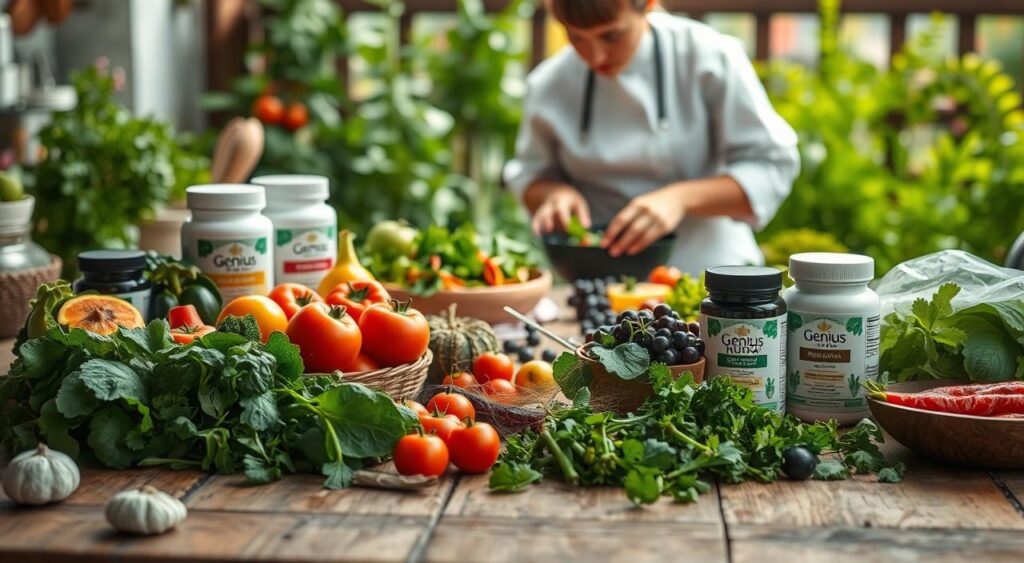
Day 4: Comforting and Easy
On Day 4, enjoy comforting dishes that are good for your body. Each meal is simple, letting you focus on the flavors. These dishes are not only healthy but also delicious.
Quick Breakfasts
Begin your day with a quick, healthy breakfast. Try avocado toast on whole-grain bread with cherry tomatoes and hemp seeds. It’s packed with healthy fats and fiber to start your day off right.
Satisfying Lunches
For lunch, have a nourishing salad with chickpeas, mixed greens, and lemon-tahini dressing. It’s full of protein and nutrients that help fight inflammation. This meal is tasty and good for you.
Relaxing Dinners
At dinner, relax with a quinoa bowl topped with roasted veggies. Add olive oil and sea salt for extra flavor. This dinner is comforting and supports healthy eating.
| Meal Type | Dish | Key Ingredients |
|---|---|---|
| Breakfast | Avocado Toast | Whole-grain bread, avocado, cherry tomatoes, hemp seeds |
| Lunch | Chickpea Salad | Chickpeas, mixed greens, lemon, tahini |
| Dinner | Quinoa Bowl | Quinoa, assorted roasted vegetables, olive oil |
Day 5: Exploring Global Flavors
Day 5 of your anti-inflammatory journey takes you on a trip around the world. You’ll enjoy meals that fight inflammation and taste amazing. You’ll see how anti-inflammatory recipes can be both diverse and delicious.
This day invites you to try different cuisines. It shows that healthy eating can be an exciting adventure.
Breakfast Around the World
Begin with a Mediterranean-inspired frittata for breakfast. Add fresh herbs, colorful veggies, and spices for a tasty dish. Eggs give you protein, and veggies add fiber and nutrients.
This dish is not just tasty but also good for you. It’s a great way to start your day.
International Lunch Picks
For lunch, try a Middle Eastern-inspired tabbouleh salad. It’s full of fresh parsley, tomatoes, and bulgur wheat. This salad is refreshing and packed with antioxidants.
The lemon juice dressing adds a zesty flavor. It’s a fantastic anti-inflammatory recipe for your week.
Worldly Dinner Inspirations
For dinner, enjoy an Asian-inspired meal with a comforting bowl of miso soup. Serve it with brown rice and steamed veggies for a complete meal. Miso has probiotics that help your gut health.
It’s a wonderful way to end your day of global flavors. You’ll stay on track with your health goals.
Day 6: Plant-Based Focus
Starting a plant-based diet can make your meals vibrant and healthy. On Day 6, you’ll find tasty vegan dishes that are good for you. They’re both nourishing and satisfying.
Vegan Breakfast Ideas
Start your day with foods that boost your energy and focus. Try oatmeal with almond milk and fresh berries. Or, make a smoothie with spinach, banana, and chia seeds. This way, you get a great start with important nutrients.
Plant-Powered Lunch
For lunch, have a big salad with mixed greens, quinoa, and roasted chickpeas. Add a light vinaigrette for flavor. This meal is full of protein, fiber, and vitamins, supporting your plant-based diet.
Meat Alternatives for Dinner
End your day with a lentil and vegetable stew. It has carrots, celery, and spices for warmth. This dish is full of protein and fiber, fitting perfectly into your anti-inflammatory meal plan. Whole, plant-based foods help reduce inflammation, making your diet journey enjoyable and healthy.
Day 7: Sweet Treats and Relaxation
Today, you’ll end your week with treats that are good for you. You can enjoy tasty foods that don’t hurt your health goals. It’s all about finding the right balance.
Indulgent Breakfasts
Begin with fluffy almond flour pancakes. Top them with fresh berries and maple syrup. These pancakes are not only yummy but also good for you.
They use almond flour, which is full of nutrients. Add a glass of almond milk for a morning pick-me-up.
Light Lunch Selections
For lunch, make a green salad with mixed greens, avocado, and cherry tomatoes. Add pumpkin seeds and chickpeas for extra protein. Finish with olive oil and lemon juice.
This meal is full of anti-inflammatory foods. It will keep you energized and healthy all afternoon.
Dine-In Favorites
End your meal plan with homemade veggie pizza. Use a whole grain crust and add bell peppers, spinach, and mushrooms. Don’t forget a bit of mozzarella cheese and low-sugar tomato sauce.
This dinner is all about using healthy ingredients. It lets you enjoy your favorite foods while staying on track with your anti-inflammatory diet.
Tips for Long-Term Success with an Anti‑Inflammatory Diet
Starting an anti-inflammatory diet can greatly improve your health. Meal prep is a big help. It saves time and keeps you from eating unhealthy foods.
Tracking your progress and celebrating small wins is important. Try new recipes and enjoy your favorite dishes. This makes meal prep more fun.
Make your meals taste good by adjusting recipes to your liking. Enjoying your food makes sticking to the diet easier. For more ideas, visit this helpful link.



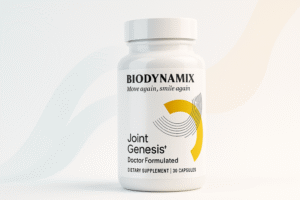








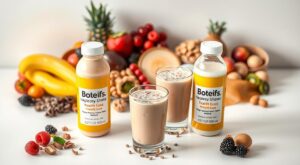
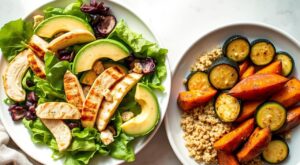

3 Responses